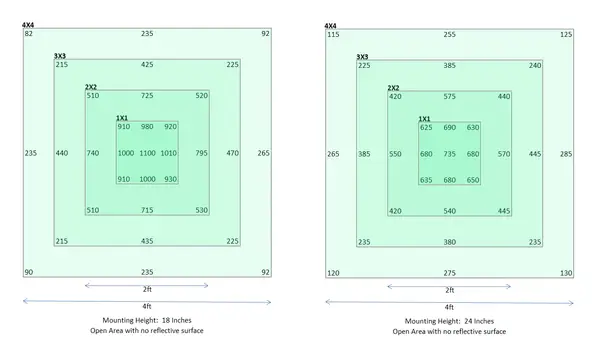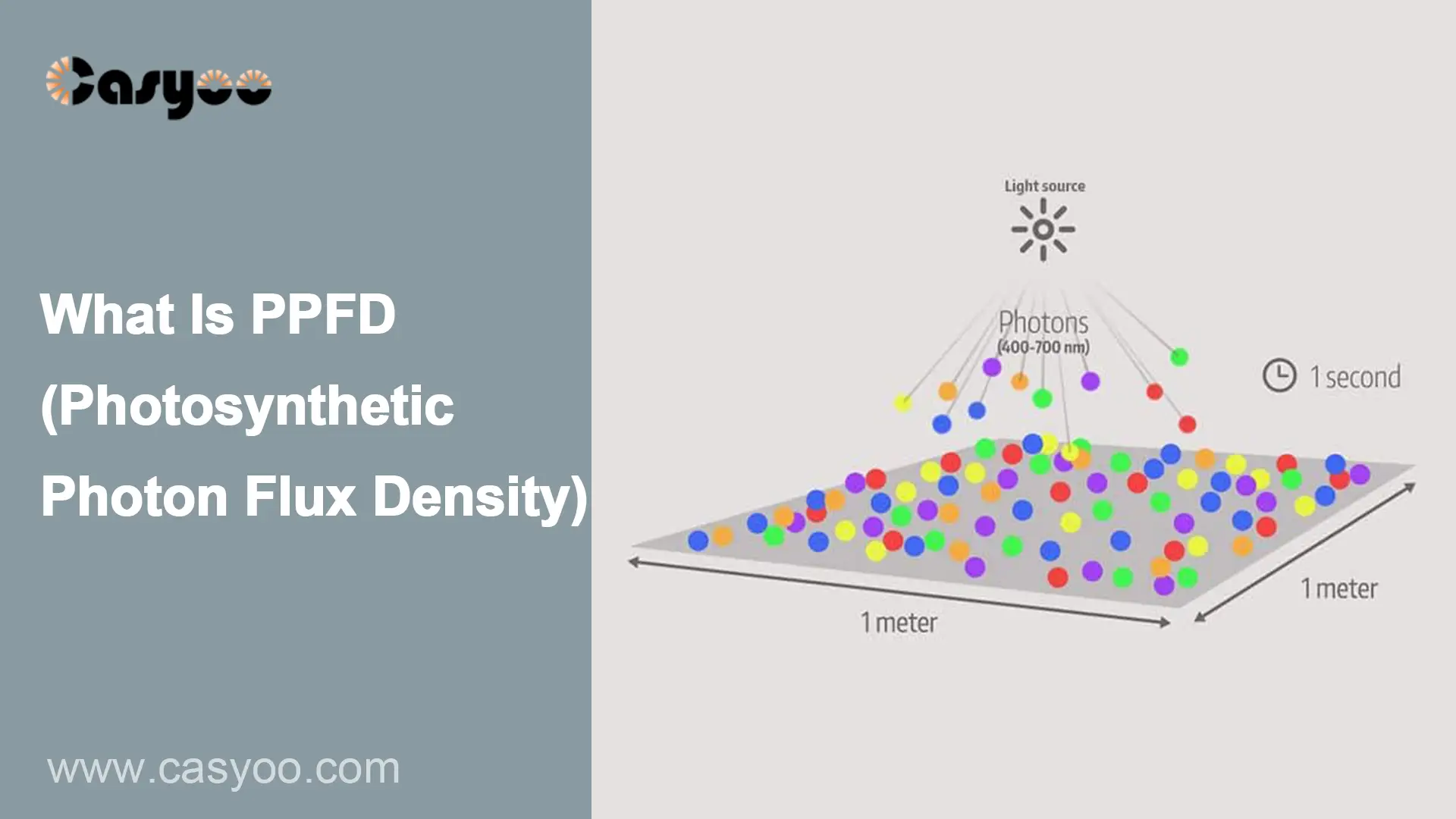What Is PPFD?
In order to quantify light conditions within a room we usually ascertain the level of illuminance. Yet, plant lighting entails quantifying the photon absorption potential via photosynthetic photon flux density (PPFD). It measures photon amount falling on crops per second in a certain unit area in the 400-700 nanometer PAR region with the measurement unit of μmol/m²/s.
A specified growth area is typically covered by several target points that are evenly spaced out on PPFD maps used in horticulture (e.g., a 4′ × 4′ growing area with measurements collected at 6′′ intervals). The number of photons landing on the plant canopy at a given height at that precise position every second is represented by each target point measurement.

What Is the Difference Between PPF and PPFD?
PPF (Photosynthetic Photon Flux) describes the number of photons the light source emits every second in the 400-700 nanometer PAR range and its unit is μmol/s. While PPF shows the total photon output by the light source, PPFD measures the density of photons the plants receive. PPF is used to measure the overall output of the light source, while PPFD expresses the use efficiency of light energy in plant photosynthesis and is the basis for lighting design optimization.
What Is the Difference Between PPFD and DLI?
Daily Light Integral (DLI) is a measurement of the total amount of photons received by plants over a whole day by photosynthetic active radiation. Its unit of measure is mol/m²/day. DLI also finds application when determining if the plants are getting the necessary amount of light. When a plant’s DLI is determined, it becomes easy to calculate the needed light duration by using the PPFD.
DLI = PPFD × light time (seconds)
To find the DLI when PPFD is 500 μmol/m²/s and the exposure duration is 12 hours (43,200 seconds) :
DLI = 500 × 43,200 × 1/1,000,000 = 21.6 mol/m²/day
Why Does It Matter?
At low levels (e.g., 100-400 μmol/m²/s), the rate of photosynthesis is higher with increasing PPFD up to the point of light saturation. The ideal light intensity enhances chlorophyll development and leaf thickening, as well as overall plant quality.
The rate of photosynthesis is at its maximum saturation point when PPFD is beyond a certain point (i.e., 600-1000 μmol/m²/s), and the photosynthesis rate tends towards saturation. CO₂ concentration, temperature, and water supply then become the main limiting factors for photosynthesis. Excessive light energy causes photoinhibition damage to the photosynthetic organs. It is thus very important to choose the optimum value for various plant species during various growth stages.
Factors That Affect PPFD
Photosynthetic Photon Efficiency of Lamps
LED lights are more effective at their job than traditional light sources since they have higher efficacy. Additionally, the emission spectrum of LEDs is tunable and can concentrate on the wavelengths that are useful for photosynthesis. Therefore, LED lights possess greater photosynthetic photon efficiency (photon efficacy), i.e., they are able to generate more PAR photons per unit power.
Number, Angle, Height, and Uniformity of Lamps
High PPFD values need to be coupled with well-distributed light if efficient plant lighting systems are to be achieved. Photoinhibition in plants happens in areas of high PPFD but areas of low intensity have lower photosynthetic potential. More lamps therefore do not necessarily result in increased PPF. Lamps instead need to be positioned with uniformity in mind. Additionally, the impact of lamp angle and height should be considered.
The use of narrow angle beams at 30 degrees will focus PPFD onto a point but may leave the edge area in a shortage of light. Broad beam angle with a spread of 120 degrees is suitably positioned for a uniform area coverage though the center area gets low intensity.
The correlation between PPFD and the height of the lamp is non-linear. Reducing the height of the lamp can boost the light intensity but might also result in non-uniform lighting.
Ambient Temperature
The performance of the lamps decreases together with their lifespan when exposed to high temperatures thus leading to low PPFD.
How Much PPFD Do Plants Need?
The value of PPFD relies on three significant parameters that are the plant species and growth stage and growth environment. The requirement for supplemental lighting systems fitted in greenhouses or vertical farms ranges from 50 to 200 μmol/m²/s. The value in dense plant populations can exceed 300 μmol/m²/s.
Lettuce and other leafy greens require 200 to 300 μmol/m²/s light intensities and 12 to 17 mol/m²/day daily light integrals. The optimum range for tomatoes and other fruiting vegetables is 500-600 μmol/m²/s with a daily light integral of 30-35 mol/m²/day.
How to Measure It?
The most widely used techniques by producers for the measurement is combining spheres and spectrometers. In these measurements, they place the plant lamp in the middle of the integrating sphere, which collects all the photons from the lamp. The spectrometer measures the spectral distribution, and from the spectral information, experts calculate the photon flux density in the 400-700 nm wavelength range to derive the PPFD. Using this data, the manufacturer can give the customer an estimated value of PPFD. They can, for instance, state that “The PPFD rate of this lamp is 1000 μmol/m²/s at the given point of measurement at 30 cm.”
For daily plant lamp users, PPFD can be measured using a hand-held PAR quantum sensor. Place the sensor at some position above the top of the plant canopy, perpendicular to the light source, and the users can directly read the value of PPFD. PPFD can be measured at multiple points to check whether the light distribution is uniform.
Related reading:




